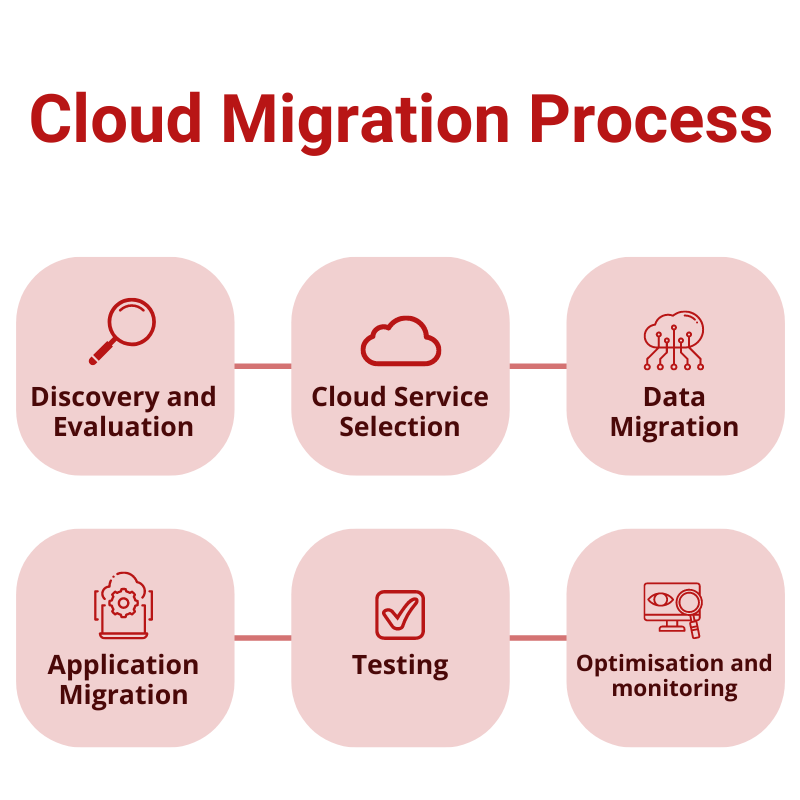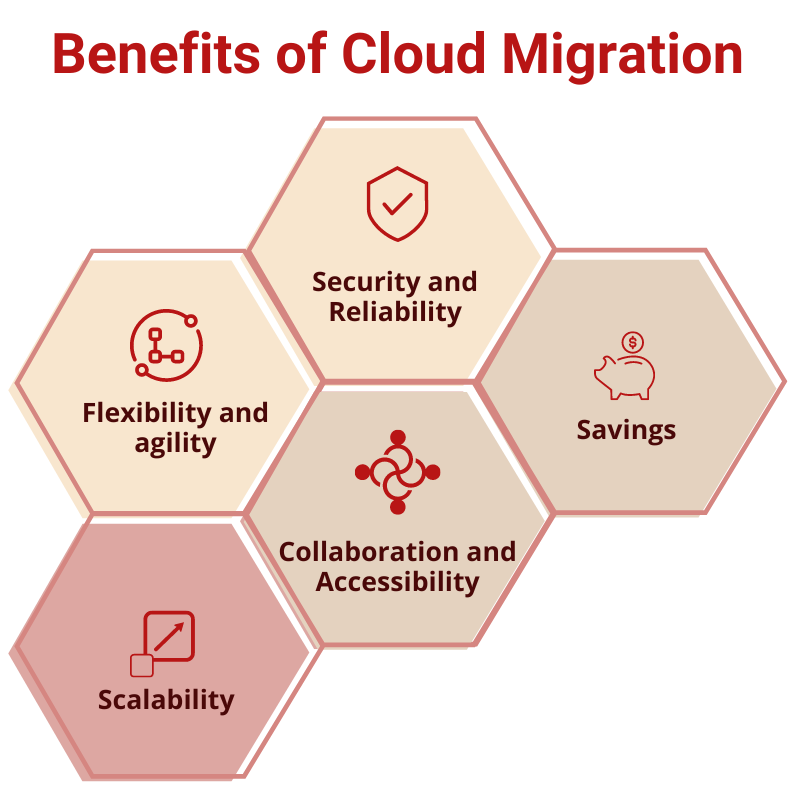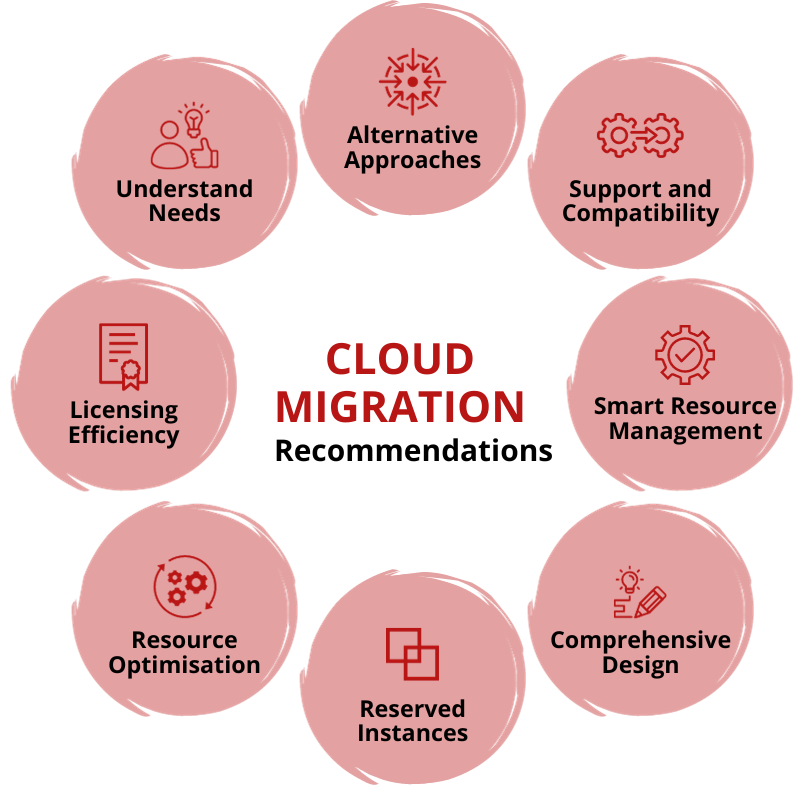
11 Sep Cloud Migration Unveiled: Understanding the Concept, Benefits, Process, and Different Approaches
Introduction to Cloud Migration
The advent of cloud computing has caused a fundamental shift in how businesses work in today’s digital world. Cloud computing allows for the efficient, scalable, and cost-effective management of data, applications, and services.
The process of migrating an organisation’s IT infrastructure, applications, and data from on-premises data centres to cloud-based platforms is referred to as migration in cloud computing. This shift enables firms to capitalise on the cloud’s potential, resulting in increased productivity, simpler operations, and enhanced overall results.


Understanding the Cloud Migration Process
Migrating data and services to a modern cloud platform requires comprehensive preparation, evaluation, and execution. It commences with a meticulous examination of the current IT ecosystem.
Subsequently, the migration goals and focal points are pinpointed, and a suitable cloud service model (Infrastructure as a Service, Platform as a Service, or Software as a Service) is chosen based on specific business needs.
The typical Cloud Migration Process encompasses the following stages:
Discovery and Evaluation: During this phase, important data regarding the organisation’s current IT infrastructure, applications, and data is collected. A detailed evaluation will identify risks, challenges and optimisation opportunities.
Cloud Service Selection: Based on the assessment results, the best cloud service model is selected based on your needs and budgetary constraints.
Data Migration: A critical stage in migration is transferring data from on-premises servers to the cloud. During this period, ensuring data security and integrity while minimising downtime is essential.
Application Migration: It is essential to migrate apps to the cloud environment to enable seamless functionality within the new framework.
Testing: Following the migration, thorough testing is performed to ensure the performance, security, and dependability of the moved apps and data.
Optimisation and monitoring: Businesses may quickly discover and address performance issues by continuously monitoring their cloud infrastructure. Efforts to optimise ensure that cost-efficiency and resource utilisation are maximised.


Benefits of Cloud Migration
Adopting cloud migration offers numerous benefits for businesses. In several cases, the move to the cloud is an opportunity to reinvent and enhance the existing environment for better outcomes.
Take a look at some of the general benefits of cloud migration.

Security and Reliability: Leading cloud service providers like Winthrop utilise robust security measures and redundancy procedures to assure data safety and high availability. This contributes to the overall security and reliability of business operations.
Flexibility and agility: Cloud-based solutions enable you to quickly respond to changing market conditions and client needs. This allows for quick innovation and experimentation, building a dynamic and competitive advantage.
Collaboration and Accessibility: Cloud-based solutions enable remote work and collaboration by allowing teams to access data and apps from any location with an internet connection. This improves team productivity and collaboration.
Savings: Using cloud computing reduces the need to invest in and maintain physical equipment, resulting in lower capital outlays. Furthermore, firms can use a pay-as-you-go approach, paying only for the resources they use.
Scalability: Cloud systems offer seamless scalability, allowing businesses to scale up or down in response to demand easily. This ensures that the resources required to manage varying workloads are available.
Navigating Cloud Migration: Decisions and Recommendations
- Critical Decision Factors Transitioning to cloud computing demands strategic evaluation in choosing the right hosting partner. The following aspects must be assessed for a seamless migration:
- Service Level Agreements: Ensure the provider guarantees the uptime your services require.
- Locations and Availability: Verify geographical proximity and redundancy for reliable connectivity.
- Security Measures: Examine physical and authentication security provisions.
- Data Policy and Privacy: Confirm documented data governance and privacy commitments.
- Pricing Model: Evaluate cost-effectiveness based on your usage.
- Scalability and Performance: Check if scaling aligns with your dynamic needs.
- Integration Capability: Ensure seamless integration with other systems.
- Business Continuity Plan: Confirm disaster recovery procedures.
- In-House Expertise: Assess your team’s proficiency in maintaining the cloud.
- Effective Management: Opt for a provider with modern management tools.
- Exit Strategy: Consider smooth transition options.
- Stability Assurance: Choose established cloud leaders.


General Recommendations
When migrating workloads, strategic planning is critical to preventing unexpected costs and performance hitches. Consider these steps:
- Understand Needs: Know your service requirements and question resource necessity.
- Alternative Approaches: Explore cloud-specific services beyond simple migration.
- Support and Compatibility: Ensure your OS aligns with cloud compatibility or consider refreshing it.
- Licensing Efficiency: Optimise costs by bringing your own licenses.
- Resource Optimisation: Select cloud resources according to your actual needs.
- Smart Resource Management: Use cloud capabilities to scale down during inactivity.
- Reserved Instances: Secure cost savings with stable workload commitments.
- Comprehensive Design: Develop a detailed plan and estimate for an efficient cloud setup.
By thoughtfully weighing these considerations and recommendations, your cloud journey will be a smooth transition toward enhanced efficiency, scalability, and operational excellence.

Cloud Migration Approaches
Lift and Shift (Rehosting) Approach
The Lift and Shift method, or Rehosting, is one of the simplest and fastest cloud migration solutions. The method transfers apps and data from on-premises infrastructure to the cloud environment with minimal changes. The primary goal is to duplicate the present setup in the cloud without changing the application’s design or code.
Although the Lift and Shift technique speeds up migration and lowers downtime, it does not always result in immediate cost savings. This is because on-premises apps may need to be completely optimised to take advantage of cloud scalability and cost-efficiency. Nonetheless, this technique is an excellent starting point for organisations looking to quickly migrate to the cloud, with the potential of further optimising their apps.
Replatforming Approach
The Replatforming strategy, known as Lift, Tinker, and Shift, involves changing programs throughout the migration process to optimise them for the cloud environment. Its primary goal is to improve application performance, scalability, and cost-effectiveness by utilising cloud-native features.
Specific components of the application may be updated or modified during the Replatforming process to fit smoothly with the target cloud platform. Compared to the Lift and Shift method, this methodology allows enterprises to achieve improved performance and cost optimisation while minimising disruptions during the transfer.
Refactoring (Rearchitecting) Approach
The Refactoring method, also known as Rearchitecting, is a thorough but time-consuming cloud migration process. Significant changes to the application’s design and code are required to effectively utilise cloud-native services and capabilities.
Businesses can optimise their cloud solutions by re-architecting their applications, resulting in enhanced performance, scalability, and cost-effectiveness. However, in order to be successful, this technique must be implemented with careful preparation, extensive development, and comprehensive testing.
Winthrop’s Comprehensive Cloud Assessment Services
We recognise that successful cloud migration starts with a thorough audit of your current IT infrastructure. To build a plan for a flawless transfer, we conduct a complete evaluation of your organisation’s systems, applications, and data.
The following phases are included in Winthrop’s approach for conducting a complete review of your current IT infrastructure:
Inventory and Discovery:
To properly understand your current landscape, we conduct a detailed inventory of your existing IT assets and applications.
Performance and Resource Analysis:
To find opportunities for optimisation, our team analyses the performance of your applications and examines resource utilisation.
Security and Compliance Review:
To ensure a secure migration process, we examine your existing security measures and compliance standards.


The importance of an accurate assessment in planning a successful migration
The foundation of successful cloud migration is an accurate assessment. It aids in the early identification of potential obstacles and risks allowing us to develop a customised migration strategy that matches your specific needs. A thorough assessment reduces the possibility of unforeseen problems during migration and enables a smooth transfer to the cloud.

Winthrop’s expertise in identifying challenges, risks, and opportunities for optimisation.
With years of experience offering cloud business management solutions, our team has seen a wide range of migration scenarios and issues. We use this knowledge to detect potential stumbling blocks in your relocation process and build contingency strategies. Furthermore, we assist you in identifying opportunities to optimise your cloud infrastructure for optimum cost savings and performance improvements.

Winthrop’s Cloud-First Strategy: Leading the Way in Digital Transformation
In an era where technology constantly evolves and innovation shapes industries, Winthrop stands at the forefront of change by adopting a cloud-first strategy. This visionary approach, driven by our leadership, propels us into the future of business operations, efficiency, and growth.
While a cloud-first strategy represents a fundamental shift in the way organisations leverage technology to achieve their goals, at Winthrop, it’s not merely a technological shift – it’s a strategic mindset that redefines how we perceive and harness the power of the cloud. This strategy centres on prioritising cloud-based solutions as the default choice for any new initiative, application, or service. It’s about acknowledging that the cloud isn’t just a tool – it’s a catalyst for transformation.
As leaders, we recognise that this approach isn’t just about technology – it’s about resilience, adaptability, and positioning ourselves as innovators in an ever-evolving landscape. Through the cloud-first strategy, we demonstrate our commitment to not only embracing change but driving it, and in doing so, we secure a brighter, more efficient future for Winthrop and those we serve.
Winding Up
Cloud migration is a critical stage in any company’s digital transformation journey. With its multiple benefits, such as cost savings, scalability, and flexibility, adopting cloud-first strategies has become an essential objective for organisations. Cloud migration needs meticulous planning, a full grasp of the current IT architecture, and careful evaluation of the best migration strategy.
At Winthrop, we take pride in providing comprehensive cloud assessment services that enable businesses to embark on their cloud migration journey confidently. We will accompany you through every step of the migration process, whether you choose the Lift and Shift, Replatforming, or Refactoring approach. We help organisations harness the cloud’s full potential and succeed in the new SaaS-driven era by embracing cloud-native technologies and rethinking how they work.



